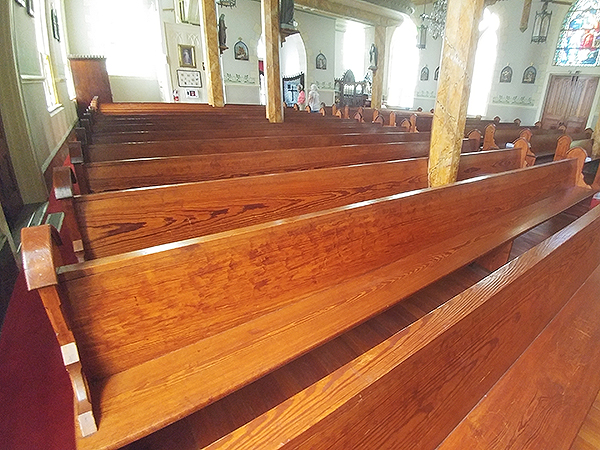
Several readers respond to Rob’s question last week about having experience with or access to heart pine lumber. — Editor
“I have not used it, but a lot of people in south Florida have. One of my friends bought an old ‘conch’ house in Key West. He salvaged all of the heart pine and reused it to rebuild. He would have bought more of it if he could. The wood gets darker and harder as it gets older. He could not drive a nail or screw into it without pre-drilling. As far as I know, there are no sources of new old-growth heart pine. All of the old-growth was harvested. Maybe one day we will see ‘new’ old growth! You get this lumber now from houses, buildings and warehouses getting torn down. Very prized and valuable. Several companies claim they have it, but it comes and goes pretty fast. The companies that I know of carry it when they can get it. You might be able to search the specialty lumber recyclers in the southeast. I think it would be well worth it for you to get some and play with it. Hearne Hardwoods (hearnehardwoods.com) lists it for sale.” – Jon Johnson
“I lived in a 1924 Bungalow here in Raleigh, NC, and it had interesting floors: heart pine in the private areas and oak in the public areas. I can’t tell you which I liked better! They were both beautiful and durable!” – Chris Tully

“I truly love the old pine that we see show up in various pieces of furniture and in buildings. Many homes were built and furnished with it here in (Austin) Texas. It grew in abundance in the eastern part of the state, which was quite heavily forested. The truly big ones are gone, sad to say. But they live on in wonderful ways. Take a look at the attached photo (above). I took this recently at one of our ‘painted churches’, which is another story in itself. The benches in this photo are 16-ft. long, bottom boards 16 in. wide and backs are 20 in. wide. All are continuous pieces of old-growth pine. The church is well over 100 years old.” – Dan Miller
“Years back I helped demo an old Cracker house here in Florida. Sadly, there wasn’t much left of it — the guy who bought the property got a little history from last family owner who claimed it was built roughly around 1860. Another house was built around the 1930’s on the property, so the original house first was like a guest house for family, then turned into storage, then sort of a barn for chickens and cows. In one room still standing we counted no less than six wooden floors that had been laid over the top of each other with many, many patches, sometimes no more than large gallon-size cans cut and nailed in place. It was now overrun with various types of critters, bugs and snakes. We only found termite damage in a few places, surprisingly. Over the years and due to settling, several additions had been made. The main supports for the house were solid 6×6 of rough-cut oak, walls were rough-cut 1-in. red pine that use to be plentiful in this area. Some walls were all rough-cut 1-in. cypress. Both wood types being bug-resistant and weathered well for the Florida environment. The sap had seeped out of the red pine and hardened, and some was still sticky after all these years. Some of it was so hard that a chainsaw would throw sparks like you were cutting metal. There were two interior walls that had the yellow pine heartwood that at some point had been painted – once I figured out what it was, I asked the guy if I could keep those boards. He laughed and said, take whatever you want. I took home two pickup truck loads and sanded them down and refinished them. Man, that was pretty wood! The old house had a tin roof on it an where the tin had touched the trusses. They were burned black from the heat of the sun over the decades. Who knows how many storms and hurricanes this now old, dilapidated shack had stood up to…I made a dining room table from the yellow pine and used some for a flooring project in the living room. You would not believe how the lights at night would dance across that floor, especially during Christmas.” – James Russo
“Where can you find yellow pine? I have not seen it in years.” – John Stephens
“I live in New Orleans, and in my opinion, Southern yellow pine (SYP) is readily available in the salvaged/reclaimed wood market. My primary experience with it is as a building/architectural material (often for flooring, where it was a traditional 19th-century choice in this region). From my singular experience (I don’t claim it to be more than that), the bulk comes from dismantled industrial structures in the upper and coastal south. From what I’ve seen at suppliers of salvaged wood, almost any furniture component (with the possible exception of single-board very wide panels) could be constructed. I believe that there may be some limited ‘sinker’ source of SYP, but unlike the local bald cypress that was often felled in the swamps and floated to a mill or other gathering point, SYP tended to be transported overland. My most recent need for the material (earlier this year) was to replace 150-year-old original weatherboards on a farmhouse renovation that my wife and I are undertaking. We found a source in New Orleans that had large beams that could be bandsawn to the correct dimensions. Over the years I have made limited use of the material for little benches, stools, etc. My experience shows that it is a very dense wood when quartersawn, and upon working it with hand or power tools, it smells as if you were in a turpentine factory.” – John H. Lawrence
“I am from South Carolina. Up until about 20 years ago, you could find a lot of good wood if you knew someone with property (like a farm) or if a building such as an old mill or an older home was being demolished. Today people are more savvy about the quality of this material, and it is often bought up by someone who is in the reclaimed lumber business. I think the finest longleaf (pine) came from the sandhill areas, since it was so slow-growing. Some of these trees might increase only an inch in diameter over a 20-year period, and many even less than that. To get a large quantity, you would have to find a structure built probably no later than the 1930’s. I am not sure where you live, but if you are in the east, even as far north as New York, you could find good longleaf lumber in a large old manufacturing building such as a textile mill. The walls were usually brick, but the floors were supported by enormous joist-like beams, often 12×16 or even larger, overlaid with 3×10 or wider decking and topped off with maple strip flooring. The pine available in the area I don’t think was strong enough or large enough, so it was often longleaf pine. As I understand it, even though the construction was wood, and a resinous type at that, a fire would cause steel beams to soften and collapse before the large size beams would ignite. And wood was certainly cheaper at that time. If you live west of the Mississippi, or in the central part of the country, I would guess that any building of this type would have timbers made of Douglas fir — beautiful also but not quite the same as longleaf and not as easy to work. Even as late as the 40’s around here, you could buy siding and quartersawn flooring from any lumberyard, and a lot of it was longleaf. A man across the street from where I grew up had a wooden house with quartersawn pine flooring and 12-in.-wide German siding. I guess we were just born too late! If you ever pass through Columbia, South Carolina, and have your truck, look me up. I would be glad to share some of my old stuff with you. (I’m 70 years old and still haven’t done anything with a lot of it.)” – Gene Lucius






